Results 361 to 370 of 12096
Thread: Anandtech News
-
03-10-11, 03:20 PM #361
Anandtech: The MacBook Pro Review (13 & 15-inch): 2011 Brings Sandy Bridge
Last year at the iPad introduction Steve Jobs announced that Apple is a mobile device company. Just last week Steve returned to introduce the iPad 2 and point out that the majority of Apple's revenue now comes from products that run iOS. The breakdown is as follows:
AAPL Revenue Sources - Q1 2011 iPad iPhone iPod Mac iTunes Store Software/Services Peripherals Percentage 17.2% 39.1% 12.8% 20.3% 5.4% 2.9% 2.2% Just looking at iPad and iPhone, that's 56% of Apple's sales. All Macs put together? Only 20%. Granted 20% of $26.7 billion in sales is still $5.3 billion, but the iOS crew gets most of the attention these days.
It shouldn't come as a surprise that when Apple launched its 2011 MacBook Pro lineup last week that it did so with little fanfare. There was no special press event and no video of an unusually charismatic man on a white background describing the latest features of the systems. All we two weeks ago were a few pages describing the high level features of the lineup, a short outage on the Mac Store and five new configurations available for sale.
We've been working non-stop since the launch on our review of the new 13-inch and 15-inch MacBook Pros. Despite the lack of fanfare, this is a pretty serious upgrade. Read on for our in-depth analysis!
More...
-
03-11-11, 08:00 PM #362
Anandtech: Nixeus Fusion XS Brings Marvell into the DMA Market
The DMA (Digital Media Adapter) aka media streamer market has been dominated by Sigma Designs, Realtek and of late, the Intel CE 4xxx series. The low end market is catered to by the Boxchip and Amlogic based media streamers.
Having got the codec compatibility right (at least on paper), the choice for the media streamer manufacturers was to either go the 3D route or add extra non-core functionality in the next-gen products. 3D is yet to go mainstream despite the best efforts of the top tier manufacturers.
In 2011, you can expect a slew of media streamers running Android. The TViX Xroid A1 has already been announced and demonstrated to be running Android on the SMP8656. Read on for our coverage of the launch of another Android-based media streamer, the Nixeus Fusion XS, which also happens to be Marvell's debut vehicle in this product space.
More...
-
03-12-11, 05:03 AM #363
Anandtech: Apple iPad 2 Preview
The second generation iPad went on sale earlier today, to much fanfare and long, long lines. We're hard at work on our full review of Apple's second generation tablet but there were a few things we wanted to chime in on before too much time passed.
Read on for our in-depth preview of the new iPad 2 including analysis of the new A5 SoC, display quality, camera performance and more.
More...
-
03-12-11, 02:20 PM #364
Anandtech: Apple iPad 2 GPU Performance Explored: PowerVR SGX543MP2 Benchmarked
Earlier this morning we published our first impressions on Apple's iPad 2, including analysis on camera quality and a dive into the architecture behind Apple's A5 SoC. Our SoC investigation mostly focused on CPU performance, which we found to be a healthy 50% faster than the A4 in the original iPad - at least in web browsing. We were able to exceed Apple's claim of up to 2x performance increase in some synthetic tests, but even a 50% increase in javascript and web page loading performance isn't anything to be upset about. We briefly touched on the GPU: Imagination Technologies' PowerVR SGX 543MP2. Here Apple is promising up to a 9x increase in performance, but it's something we wanted to investigate.
Read on to see just how fast the new PowerVR SGX 543MP2 really is.
More...
-
03-14-11, 07:12 AM #365
Anandtech: Dell Venue Pro: Lightning Strikes
When we first looked at the retail Windows Phone 7 devices back in September of last year, we had one general takeaway - the hardware, regardless of manufacturer, was fairly conservative. Samsung’s popular Focus is basically just a respecced version of the Galaxy S phone template, while HTC ended up giving the HD2 a mild refresh to create the HD7. The launch was focused on Microsoft’s shiny new OS, but there was one handset that stood out to me - Dell’s new Venue Pro.
Dell has been getting serious about returning to the handheld game, starting with the 5” Streak last year, and now with their stable of smartphones and tablets releasing this year. The Venue Pro was the first to hit market, and it’s a very strong first strike. It’s a portrait slider with a QWERTY keyboard, a 4.1” AMOLED screen, and Snapdragon underhood, and I think it’s the most compelling Windows Phone 7 device released thus far.
Read on to see why.
More...
-
03-14-11, 08:30 AM #366
Anandtech: Cebit 2011: Some Quick Server Related Impressions
We can not say that we are dazzled by the amount of new products at CeBIT. Most demonstrations we saw and documentation we found of the tier-one OEMs were in German, a clear sign that CeBIT is getting a little bit less international each year.
As we also visited this event only for a few hours, we focused on a few extraordinary products of the more international oriented companies like Tyan and Supermicro.
More...
-
03-14-11, 04:00 PM #367
Anandtech: More of AMD’s Brazos E-350 with the MSI X370 and Sony VAIO YB
It may have taken some time for AMD’s Fusion to finally arrive, but now it’s here and we’re starting to see a decent number of Brazos laptops. We’ve already reviewed HP’s dm1z, which set the bar that other manufacturers will have to match or exceed. Today, we add two more E-350 laptops to the mix of reviews, one an 11.6”-screen and the other a 13.3”-screen chassis.
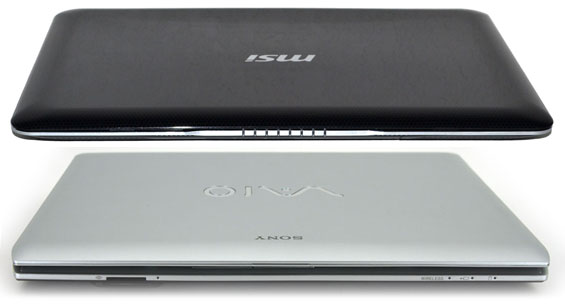
In the black corner, we have MSI’s ultra-slim X-series laptop, the X370; in the silver corner is a smaller competitor in Sony’s VAIO YB. How do these two compare with the HP dm1z and with each other? What are the benefits and detriments involved with moving to a larger chassis? And is the Brazos platform right for you? That’s what we’re going to discuss in this head-to-head matchup.
More...
-
03-14-11, 08:30 PM #368
Anandtech: OCZ Grows Up, Signs Definitive Agreement to Acquire Indilinx
We first met Indilinx in early 2009, with its Barefoot controller at the heart of OCZ's Vertex SSD. Until SandForce showed up in 2010 with the SF-1200/1500 series of controllers, the Indilinx Barefoot was the cheaper alternative to Intel. If it wasn't for Indilinx I'm not sure Intel would've had any real competition until last year.
The OCZ/Indilinx relationship was always a close one, but it's about to get a lot closer. Today OCZ announced that it has signed a definitive agreement to acquire Indilinx Co., Ltd for ~$32M in OCZ shares. The deal is expected to close within 30 days.
Why would OCZ acquire Indilinx? To be honest, it's the only way to ensure growth in the future. While OCZ is currently the retail/channel face of SandForce, SF also happens to sell to all of OCZ's competitors. OCZ may get early access to SandForce hardware, but so could anyone else who shows up with a big enough check. Ultimately to stick around in this business OCZ needs to be able to build its own controller and that's what the Indilinx acquisition is designed to allow.
Indilinx was working on its first 6Gbps controller codenamed Jet Stream, however the design never surfaced. Delays do happen in chip design and I'm guessing Indilinx just couldn't make it happen with Jet Stream.
What does this mean for SSDs today? Porbably very little. OCZ will continue to ship SandForce based drives, however at some point I'm expecting to see an exclusive OCZ branded controller. While this move will likely guarantee OCZ's ability to differentiate amongst its smaller competitors, I'm not entirely convinced it will be enough to compete with the likes of SandForce. We've even seen Intel struggle with that battle.
Anything can happen though. Two years ago I didn't expect anyone other than Intel to dominate SSDs. A year ago it was SandForce. By this time next year anything could happen.
More...
-
03-15-11, 08:10 AM #369
Anandtech: NVIDIA's GeForce GTX 550 Ti: Coming Up Short At $150
Throughout the lifetime of the 400 series, NVIDIA launched 4 GPUs: GF100, GF104, GF106, and GF108. Launched in that respective order, they became the GTX 480, GTX 460, GTS 450, and GT 430. One of the interesting things from the resulting products was that with the exception of the GT 430, NVIDIA launched each product with a less than fully populated GPU, shipping with different configurations of disabled shaders, ROPs, and memory controllers. NVIDIA has never fully opened up on why this is – be it for technical or competitive reasons – but ultimately GF100/GF104/GF106 never had the chance to fully spread their wings as 400 series parts.
It’s the 500 series that has corrected this. Starting with the GTX 580 in November of 2010, NVIDIA has been launching GPUs built on a refined transistor design with all functional units enabled. Coupled with a hearty boost in clockspeed, the performance gains have been quite notable given that this is still on the same 40nm process with a die size effectively unchanged. Thus after GTX 560 and the GF114 GPU in January, it’s time for the 3rd and final of the originally scaled down Fermi GPUs to be set loose: GF106. Reincarnated as GF116, it’s the fully enabled GPU that powers NVIDIA’s latest card, the GeForce GTX 550 Ti.
More...
-
03-15-11, 01:50 PM #370
Anandtech: Intel Plans on Bringing Atom to Servers in 2012, 20W SNB Xeons in 2011
The transition to smaller form factors hasn't been exclusively a client trend over the past several years, we've seen a similar move in servers. The motiviation is very different however. In the client space it's about portability, in the datacenter it's about density. While faster multi-core CPUs have allowed the two-socket 1U server to really take off, they have also paved the way for a new category of density optimized servers: the micro server.
The argument for micro servers is similar to that for ultra low power clients. Only a certain portion of workloads really require high-end multi-socket servers, the rest spend much of their time idle and thus are better addressed by lower power, higher density servers. Johan typically argues that rather than tackling the problem with micro servers it's a better idea to simply increase your consolidation ratio into fewer, larger servers. There are obviously proponents on both sides of the fence but Intel estimates that the total market for micro servers will reach about 10% of its total shipments over the next 4 - 5 years. It's a small enough market for Intel not to be super concerned about but large enough that it needs to be properly addressed.
Today Intel believes that it addresses this market relatively well with the existing Xeon lineup. Below is a table of Sandy Bridge Xeons including a 45W and 20W part, these two being directed primarily at the micro server market:
Intel SNB Xeon Lineup Intel Xeon Processor Number Cores / Threads Clock Speed Single Core Max Turbo L3 Cache Memory Support (Channels / DIMMs / Max Capacity) Power (TDP) E3-1280 4 / 8 3.50GHz 3.90GHz 8MB 2 / 4 / 32GB 95W E3-1270 4 / 8 3.40GHz 3.80GHz 8MB 2 / 4 / 32GB 80W E3-1260L 4 / 8 2.40GHz 3.30GHz 8MB 2 / 4 / 32GB 45W E3-1240 4 / 8 3.30GHz 3.70GHz 8MB 2 / 4 / 32GB 80W E3-1230 4 / 8 3.20GHz 3.60GHz 8MB 2 / 4 / 32GB 80W E3-1220L 2 / 4 2.20GHz 3.40GHz 3MB 2 / 4 / 32GB 20W E3-1220 4 / 4 3.10GHz 3.40GHz 8MB 2 / 4 / 32GB 80W Drop clock speed (and voltage) low enough and you can hit the lower TDPs necessary to fit into a micro server. Thermal constraints are present since you're often cramming a dozen of these servers into a very small area.
Long term there is a bigger strategy issue that has to be addressed. ARM has been talking about moving up the pyramid and eventually tackling the low end/low power server market with its architectures. While Xeon can scale down, it can't scale down to the single digit TDPs without serious performance consequences. Remember the old rule of thumb: a single microprocessor architecture can only address an order of magnitude of TDPs. Sandy Bridge can handle the 15 - 150W space, but get too much below 15W and it becomes a suboptimal choice for power/performance.
The solution? Introduce a server CPU based on Intel's Atom architecture. And this is the bigger part of the announcement today. Starting in 2010 Intel will have an Atom based low power server CPU with sub-10W TDPs designed for this market. Make no mistake, this move is designed to combat what ARM is planning. And unlike the ultra mobile space, Intel has an ISA advantage in the enterprise market. It'll be tougher for ARM to move up than it will be for Intel to move down.
Intel's slide above seems to imply that we'll have ECC support with this server version of Atom in 2012, which is something current Atom based servers lack.
The only real question that remains is what Atom architecture will be used? We'll see an updated 32nm Atom by the end of 2011 but that's still fundamentally using the same Bonnell core that was introduced back in 2008. Intel originally committed to keeping with its in-order architecture for 5 years back in 2008, that would mean that 2012 is ripe for the introduction of an out-of-order Atom. Whether or not that updated core will make it in time for use in Atom servers is still up for debate.
More...
Thread Information
Users Browsing this Thread
There are currently 50 users browsing this thread. (0 members and 50 guests)






 Quote
Quote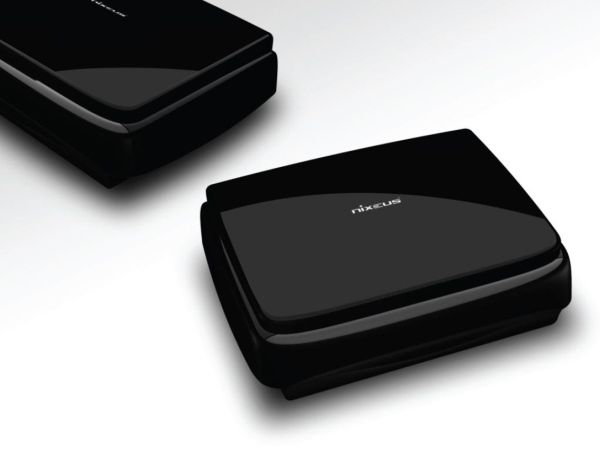
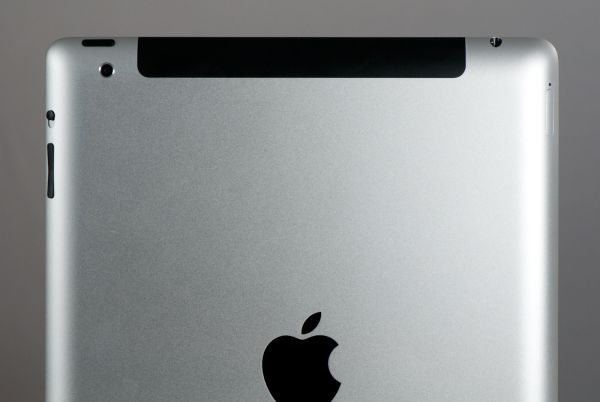

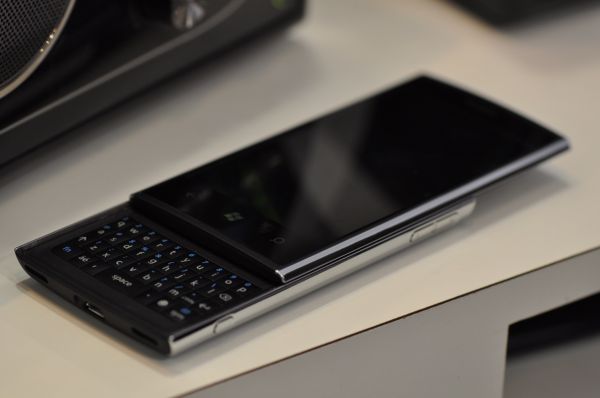


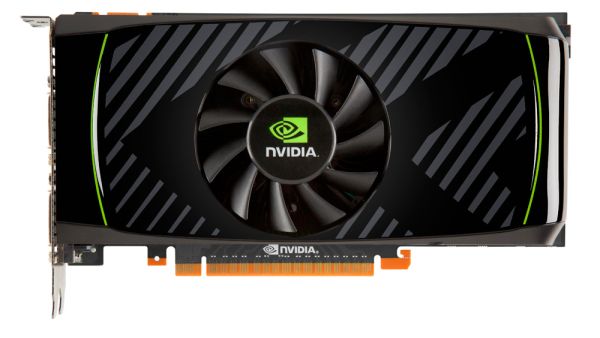
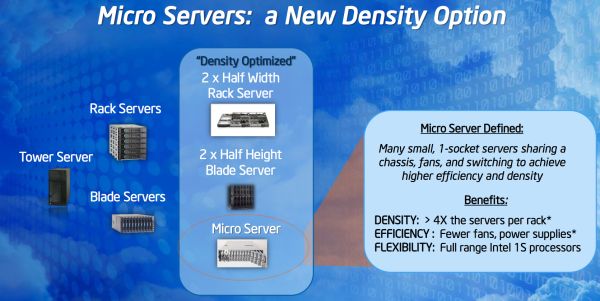
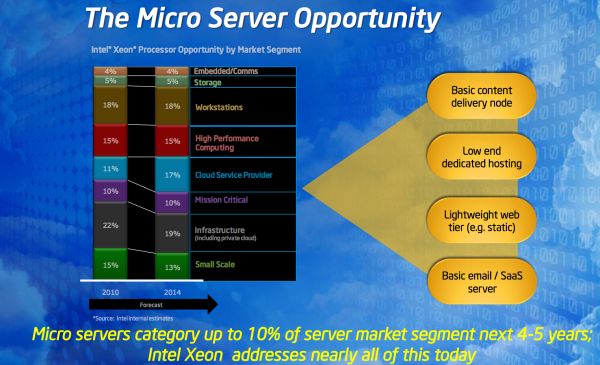
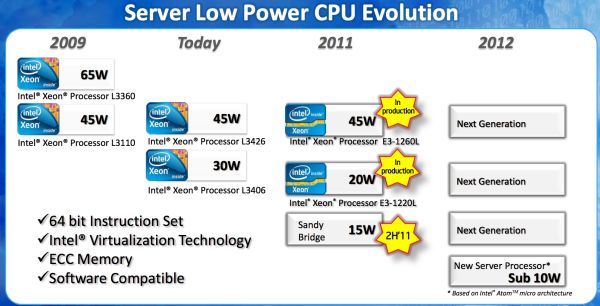
















Bookmarks